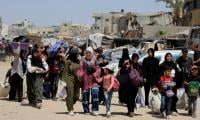Recently, a video clip showing a violent mob stripping, assaulting and parading two women in India’s north-eastern state of Manipur went viral on social media, jolting most of India and other parts of the world. The26-second video contains disturbing images of a woman and her daughter from the predominantly Christian Kuki-Zo tribe, suffering harm and humiliation at the hands of dozens of maniacal men from the Hindu Meitei tribe in B Phainom village of Kangpokpi district. The duo was forcibly escorted to an empty field where the daughter, aged 21, was gang-raped. In another incident that happened a day after the earlier one, two other Kuki-Zo women from Khopibung village of Kangpokpi district were locked up in a room in state capital Imphal and sexually assaulted by at least six men. The victims were found dead in the room hours later.
Ironically, in both loathsome incidents in Manipur, a Bharatiya Janata Party (BJP) ruled state that has long been hit by insurgency, police behaved as silent spectators. But, it was not for the first time that Manipur had witnessed rape and sexual violence against the women. According to Patricia Mukhim, a renowned social activist and editor of Shillong Times, Indian military has used rape as an instrument of subjugation in Manipur from 1980s until around 2000 with impunity to crush an uprising there. Such crimes would be either committed by the Indian security forces them or by the Hindu zealots under the protection and patronage of the security forces, she says. Pertinently, Manipur is not the only place in India where violence against the women has become the new normal, particularly during a conflict situation, including anti-minority riots. Though India’s history of the past 75 years is replete with such ghastly happenings, the Manipur incident has however revived calls for accountability, justice and other punitive measures to prevent recurrence of such heinous acts in a country of 1.4 billion people.
Previously as well, international human rights organizations have frequently expressed serious concerns over the use of rape as a ‘weapon of war’ by the Indian security forces. Incidents of sexual violence by them as a tool to humiliate, degrade, and further marginalize the minority communities are not uncommon but have been routinely reported from different parts of the country with a discriminatory caste system and a history of conflict and unrest. In the disputed Himalayan region of Jammu and Kashmir, struggling to overthrow India’s illegal occupation, and several parts of India’s insurgency hit northeast, there have been numerous documented cases of rape and sexual assault, often targeting civilian populations, precisely women and young girls. The victims in most of these instances belong to the minority communities, making them even more vulnerable to abuse and exploitation. Lending credence to this allegation, Megha Kumar, an Oxford-based scholar and historian of Indian origin, has stated in her book “Communalism and Sexual Violence: Ahmedabad since 1969” that sexual violence has been a feature of several communal conflicts in India, specially targeting women from minority communities. According to her research, at least 150 to 200 women were the victims of sexual violence during the 2002 anti-Muslim pogrom in the western state of Gujarat.
In 2002, Gujarat, then ruled by Narendra Damodardas Modi as chief minister, witnessed what is generally referred to as communal violence but in effect it was a planned pogrom against the Muslim minority. In its report on the Gujarat riots, Amnesty International accused the state machinery of having failed in protecting the women from violence. Around 200 women and girls were believed to have been raped and many of them thrown in the fire while they were alive. According to one survivor, even the very old women who were not raped were also stripped first before being thrown in the fire. As it was not enough, pregnant women were shown the bodies of their unborn babies and children were force-fed petrol before being lit on fire. Forced nudity, mass rapes, gang rapes, mutilation, swords insertion into bodies, and breast-cutting were all examples of “sexual violence” mentioned in the report. The violence was fuelled by extremist Hindu groups, and accusations of state complicity in the violence have been established by various independent sources. Lately, it was reinforced by the BBC as well in its investigative documentary titled “India: The Modi Question.”
These details make it pertinent to draw parallels between the incidents of Manipur and Gujarat in Indian Union and Kunanposhpora in India occupied Kashmir, as several common themes emerge when the connection between mass rapes and role of uniformed forces in the conflict-ridden areas of India is analysed.
The Kunanposhspora incident was a mass rape that took place on February 23, 1991, when an Indian security force unit (Rajputana Rifles) conducted a so-called search operation in the twin villages of Kunan and Poshpura in the remote Kupwara district of occupied Kashmir, allegedly after being fired upon by the militants. Reports suggested that the Indian security forces were involved in the rape of several women, some as young as eight years and some as old as 80 years. The number of victims is assessed to be little over 100 according to Human Rights Watch and 23 according to the local police. The incident sparked widespread outrage and highlighted issues of impunity and lack of justice in conflict zones.
In all three cases, there are allegations or evidence of state actors either directly participating in the violence or turning a blind eye towards the actions of the extremist groups. This perceived or actual state support has led to limited accountability for the perpetrators, hindering the delivery of justice to the victims. In each of these cases, minority women were specifically targeted as a means to exert control and dominance and instil fear among the already marginalized communities they belonged to. International human rights watchdogs, such as Amnesty International, Human Rights Watch and the United Nations Human Rights Council, have conducted investigations and documented these incidents.
Their reports paint a disturbing picture of systematic abuse, wherein rape is employed as a means of control, intimidation, and punishment against civilian populations. One of the major concerns raised by these organisations is the lack of accountability and justice for the survivors. In many cases, the perpetrators enjoy a culture of impunity, shielded by the laws that provide security forces with immunity from prosecution. This lack of accountability sends a dangerous message that such actions will go on unpunished, perpetuating a cycle of violence and abuse. All three incidents occurred in regions marked by political or communal conflict, where underlying tensions were exploited by the extremist Hindu groups to incite violence against the minorities. In such an environment, minority groups face increased vulnerability to violence and abuse. The incidents represent gross violations of human rights and have garnered international attention, leading to the calls for accountability and justice. The survivors of such violence often suffer long-lasting physical, psychological and emotional trauma, which is protracted in the absence of justice and support.
It is why the concerns voiced by the international human rights organisations also underscore the need for comprehensive reforms within the Indian security forces. While training programmes focused on human rights, gender sensitivity and prevention of sexual violence are required to address this deeply ingrained issue, bringing the perpetrators of such despicable crimes is equally critical to rebuilding public trust and preventing future abuses.
The concerned global organisations have also called for the repeal of laws that grant immunity from prosecution to India’s security forces and other rogue elements enjoying backing of state machinery in cases of sexual violence. But Mr Modi seems unmoved. It remains a bitter fact that not on a single occasion he appeared regretful and remorseful when his men in uniform or the fanatic BJP-RSS goons resorted to planned acts of violence against women in occupied Jammu and Kashmir and in different Indian states as part of New Delhi’s devious stratagem to subdue the oppressed communities in this manner. Had the grisly crime in Manipur not gone viral on social media, he would not have broken his silence to express a feeling of guilt.
Interestingly, during his recent state visit to the US, the unrepentant Indian leader drew a lot of flak, as during the BJP rule India has seen an upsurge in serious human rights breaches, many of which have become pervasive and systemic. These violations mostly affect Muslims, Christians, and other minorities, as well as human rights defenders and dissenters. Modi government’s desperate attempts to downplay its ill-treatment of minorities notwithstanding, former US President Barack Obama could not help but sound a note of warning. In an interview with CNN’s Christiane Amanpour, Mr Obama said there was a strong possibility that India would at some point start pulling apart, if it did not protect the rights of ethnic minorities in India.
Interestingly, India has ratified various international conventions and treaties that commit the country to uphold human rights standards, including the rights of women and the prohibition of torture and cruel, in human, or degrading treatment. However, it is emboldened by the ambivalence of major powers. As the situation worsens with each passing day, it’s high time these powers give up humming and hawing and ask India to put a stop to the state sponsored crimes against humanity and improve its dismal human rights record. Meanwhile, India must also get the message that there are intrinsic limits to the attempts of the authoritarian governments to suppress or censor the truth, no matter how much they may try to hide the acts of brutality, including the weaponisation of rape.
The writer is a Muzaffarabad based political and social analyst and human rights campaigner.
Federal Minister for Planning and Development Ahsan Iqbal presides over a meeting on July 26, 2024. —...
Federal Minister for Communications, Privatization and Board of Investment, Abdul Aleem Khan visits the site of the...
A farmer sprinkles fertiliser in a field. —APP/FileIslamabad:Experts have called for deepening China-Pak cooperation...
Sri Lankan High Commissioner to Pakistan Admiral Ravindra C Wijegunaratne speaks at an event on June 25, 2024. —...
A vendor is seen busy making traditional bread at a tandoor. — APP/FileRawalpindi:The naanbais have started defying...
Representational image of a police tape restricting an incident site. — Reuters/FileRawalpindi:Two people have died...







